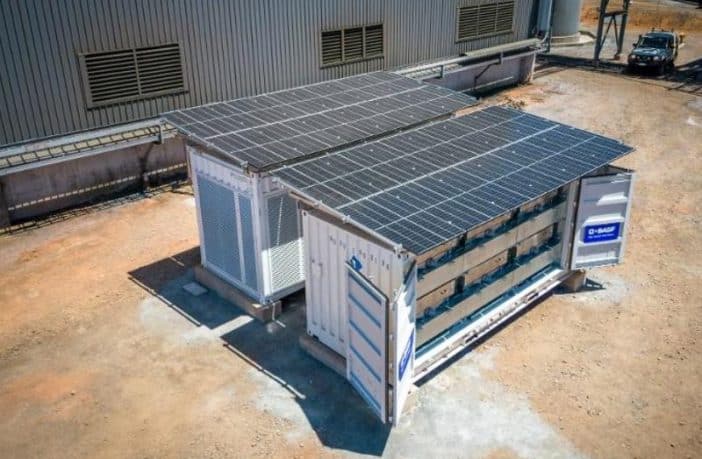This Earth Day let’s take a look at energy storage! The world is filled with so much doom and gloom, especially when it comes to the environment and climate change. Instead of dwelling on all of the negative things like endangered species loss, ocean acidification, and mountains of plastic I’d like to take a minute to showcase some of the incredible work taking place in the world of energy storage!
Batteries aren’t new, they are simple creations at their heart, with some being nothing more than a temperature differential and a gas that flows from hot to cold running an engine. In the crudest sense, a dam and water wheel is a battery. The oldest water wheel is the Perachora wheel excavated from Perachora, an inland settlement in the Loutraki-Perachora municipality of the Corinthia prefecture in Greece. This wheel is considered the earliest evidence of a water-driven wheel, highlighting the Greeks’ pioneering role in watermill technology. The Greeks not only invented the waterwheel but also developed the toothed gearing, which was crucial for the functioning of undershot, overshot, and breastshot water wheel mills.
But these aren’t the batteries most people think of. In the sense of small compact high density energy storage device, the first battery was invented by Italian physicist Alessandro Volta in 1800. He developed the voltaic pile, a battery that consisted of alternating zinc and silver (or copper and pewter) disks separated by paper or cloth soaked in salt water or sodium hydroxide. This groundbreaking invention provided a continuous and reliable source of electric current, revolutionizing the field of electrical experimentation and paving the way for the development of modern batteries.
Incredible progress has been made since that time, exponentially so in the last two decades with batteries becoming cheaper and more efficient than our ancestors could ever have dreamed. The following is a breakdown of common and some not-so-common battery types, their energy density, and their common use cases.
| Battery Type | Energy Density (Watt hours/kg) | Most Common Use | Materials |
| Li-ion | 100-265 | Electronics, EVs | Lithium, Carbon, Organic Solvents |
| Ni-Cd | 40-60 | Portable Electronics | Nickel, Cadmium, Alkaline Electrolyte |
| NiMH | 60-120 | Hybrid Vehicles | Nickel, Metal Hydride, Alkaline Electrolyte |
| Lead-Acid | 30-50 | Automotive, Backup Power | Lead, Lead Dioxide, Sulfuric Acid |
| NaS | 100-160 | Grid-Level Storage | Sodium, Sulfur, Ceramic Electrolyte |
| Li-S | 250-400* | High-Energy Applications | Lithium, Sulfur, Organic Solvents |
| Solid-State | 200-500* | High-Energy Applications | Lithium, Solid Electrolyte, Inorganic Materials |
*Estimated values for Li-S and Solid-State batteries as they are still under development.
Perhaps the most common battery that people are familiar with is the lithium-ion battery. This battery uses lithium, a lightweight and high-potential metal, along with carbon and solvents to enable the movement of lithium ions between the anode and cathode (positive and negative terminals). Lithium-ion batteries are widely used and have a relatively simple working principle, making them a popular choice for powering many devices that require battery power.
Contemporary Amperex Technology Co. Limited (CATL) is the largest manufacturer of lithium-ion batteries, with a significant market share of 37.0% in 2022. CATL supplies lithium-ion batteries to major electric vehicle (EV) automakers like Tesla, Peugeot, Hyundai, Honda, BMW, Toyota, Volkswagen, and Volvo, showcasing the company’s wide-ranging impact in the automotive industry. Tesla is currently working on increasing energy density and efficiency with a new 4680 battery design. Tesla’s 4680 battery cell design represents a significant evolution in battery technology, aiming to improve energy density, cost, and manufacturability over its predecessors. These cells are larger and employ a tabless design, which enhances thermal characteristics and simplifies manufacturing. The structural integration of these cells into the vehicle’s design is expected to reduce overall weight and improve safety. Tesla has been working on overcoming production challenges, with a goal to achieve a 70% reduction in capital expenditure per gigawatt hour when fully ramped.
But Lithium isn’t the only battery material available. Nickel is another commonly used material. Ni-Cd and NiMH batteries are two types of rechargeable batteries with distinct characteristics. Ni-Cd batteries, the first commercially available rechargeable option, contain cadmium, a toxic heavy metal. They exhibit a memory effect and require periodic full discharge. NiMH batteries have a higher energy density and reduced susceptibility to memory effects. They are more environmentally friendly due to the absence of toxic cadmium. Both battery types vary in charging characteristics, with NiMH batteries offering a more flexible charging pattern. Additionally, NiMH batteries have a longer lifespan and are lighter than Ni-Cd batteries. Nickel batteries are cheaper to manufacture but are much less energy dense, making them ideal for electronic devices.
Solid-state batteries are a type of battery that uses solid materials to facilitate the movement of ions between the cathode and anode, unlike traditional lithium-ion batteries that use liquid or polymer electrolytes. The solid electrolyte in these batteries is a key component that enables the transfer of lithium ions, thus allowing for energy storage and release. Solid-state batteries are a promising advancement in battery technology, aiming to overcome some of the limitations associated with traditional lithium-ion batteries. They utilize a solid electrolyte instead of a liquid one, which offers several advantages such as higher energy density, shorter manufacturing times, rapid charging capabilities, and a reduced risk of fires. This makes them a potential game-changer in the electric vehicle (EV) market, as they could significantly improve EV performance and address some major limitations of current lithium-ion batteries.
However, the transition to mass production of solid-state batteries is expected to happen after 2030, and there are still challenges to overcome. One of the main issues is the formation of dendrites, which can cause the battery’s life to diminish faster. Despite these challenges, leading companies such as BMW, Nio, Toyota, and Nissan are investing in solid-state battery technology and working towards integrating it into their electric vehicle lineup in the coming years.
In comparison to Ni-Cd, NiMH, and Lithium batteries, solid-state batteries offer a higher energy density and shorter manufacturing times, which could make them more efficient and cost-effective in the long run. Additionally, their reduced risk of fires is a significant safety advantage over traditional lithium-ion batteries. However, as of now, the technology is still under development, and mass production and commercial availability at a large scale are yet to be achieved.
In a solid-state battery, the solid electrolyte material serves as a conductive medium for the flow of ions, which is crucial for the battery’s operation. This solid electrolyte has the advantage of being more stable than liquid electrolytes, reducing the risk of battery fires or explosions. Additionally, solid-state batteries have the potential to offer higher energy density, faster charging times, and longer lifespans compared to traditional lithium-ion batteries.
The working principle of solid-state batteries involves the movement of ions through the solid electrolyte to allow for the flow of electrons and the storage of energy. This process enables the battery to charge and discharge, providing power to a device.
Not all batteries are for cars! Some more exotic battery types are for large scale infrastructure. Molten salt batteries use molten salts as the electrolyte, which can operate at high temperatures. They have been explored for applications like grid-scale energy storage and electric vehicles, with some promising developments in terms of energy density and long-term storage capabilities. However, they generally require high operating temperatures, which can pose challenges in terms of material durability and system design.
Sodium-ion batteries utilize sodium ions (Na+) instead of lithium ions (Li+) as the charge carriers. They have gained attention as a potential alternative to lithium-ion batteries due to the abundance and low cost of sodium. Sodium-ion batteries show promise in terms of safety, cost, and resource availability, but they still need further development to improve their energy density and cycle life to be competitive with lithium-ion batteries.
As we celebrate Earth Day, it’s important to stay positive and recognize the remarkable progress made in the field of energy storage. The development of more efficient and sustainable battery technologies, such as lithium-ion, solid-state, and other emerging alternatives, has paved the way for a cleaner and more energy-independent future. These advancements not only improve the performance and safety of batteries but also have the potential to significantly reduce our reliance on fossil fuels, supporting the transition to renewable energy sources. As we continue to innovate and overcome the challenges associated with energy storage, we move closer to a world where clean, sustainable energy is accessible to all, contributing to a healthier planet for future generations.


